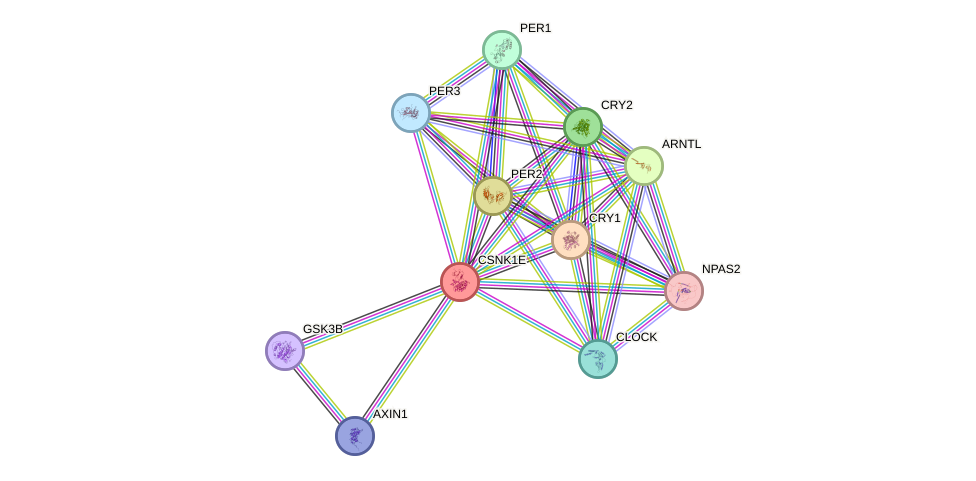GenAge entry for CSNK1E (Homo sapiens)
Gene name (HAGRID: 244)
- HGNC symbol
- CSNK1E
- Aliases
- HCKIE; CKIE; CKIepsilon
- Common name
- casein kinase 1, epsilon
Potential relevance to the human ageing process
- Main reason for selection
- Entry selected based on indirect or inconclusive evidence linking the gene product to ageing in humans or in one or more model systems
- Description
CSNK1E is a member of the serine/threonine protein kinase family. It can phosphorylate a number of proteins, including circadian rhythm proteins, meaning it may be involved in many processes.
The tau mutation in CSNK1E is a semidominant autosomal allele that shortens the length of circadian rhythms in Syrian hamsters [1831]. It also increases metabolic rate [1835]. In these animals, this mutation decreases longevity under normal conditions [1833], but if animals are kept in darkness and under constant temperature lifespan is extended 14-16% [1426], though it is not clear ageing is delayed.
Cytogenetic information
- Cytogenetic band
- 22q13.1
- Location
- 38,290,691 bp to 38,318,084 bp
- Orientation
- Minus strand
Protein information
- Gene Ontology
-
Process: GO:0000086; G2/M transition of mitotic cell cycle
GO:0006281; DNA repair
GO:0006364; rRNA processing
GO:0006468; protein phosphorylation
GO:0006897; endocytosis
GO:0007165; signal transduction
GO:0008360; regulation of cell shape
GO:0016055; Wnt signaling pathway
GO:0018105; peptidyl-serine phosphorylation
GO:0030178; negative regulation of Wnt signaling pathway
GO:0032091; negative regulation of protein binding
GO:0032436; positive regulation of proteasomal ubiquitin-dependent protein catabolic process
GO:0032922; circadian regulation of gene expression
GO:0034613; cellular protein localization
GO:0042752; regulation of circadian rhythm
GO:0048512; circadian behavior
GO:0090263; positive regulation of canonical Wnt signaling pathway
GO:1902004; positive regulation of beta-amyloid formation
GO:1903827; regulation of cellular protein localization
GO:1905426; positive regulation of Wnt-mediated midbrain dopaminergic neuron differentiation
GO:1990090; cellular response to nerve growth factor stimulus
GO:2000052; positive regulation of non-canonical Wnt signaling pathway
Cellular component: GO:0005634; nucleus
GO:0005654; nucleoplasm
GO:0005737; cytoplasm
GO:0005829; cytosol
GO:0030426; growth cone
GO:0030529; intracellular ribonucleoprotein complex
GO:0043025; neuronal cell body
Hide GO termsFunction: GO:0004672; protein kinase activity
GO:0004674; protein serine/threonine kinase activity
GO:0005515; protein binding
GO:0005524; ATP binding
GO:0044822; poly(A) RNA binding
Protein interactions and network
- Protein-protein interacting partners in GenAge
- TP53, MYC, APP, PCMT1, MAPK9, PPP1CA, CSNK1E, ARNTL, CLOCK
- STRING interaction network
Retrieve sequences for CSNK1E
Homologs in model organisms
- Caenorhabditis elegans
- kin-20
- Danio rerio
- csnk1e
- Drosophila melanogaster
- dco
- Mus musculus
- Csnk1e
- Rattus norvegicus
- Csnk1e
- Saccharomyces cerevisiae
- HRR25
Selected references
External links
- EPD
- ORF Accession
- NM_001894
- CDS Accession
- NP_001885
- OMIM
- 600863
- HPRD
- 02919
- Ensembl
- CSNK1E
- UniProt/Swiss-Prot
- KC1E_HUMAN
- GeneCards
- CSNK1E
- Entrez Gene
- 1454
- GenAtlas
- CSNK1E
- Internet
- Search Google


